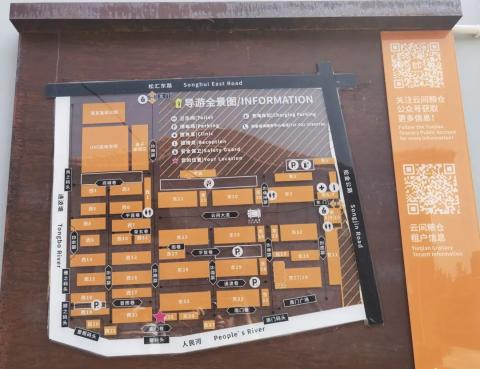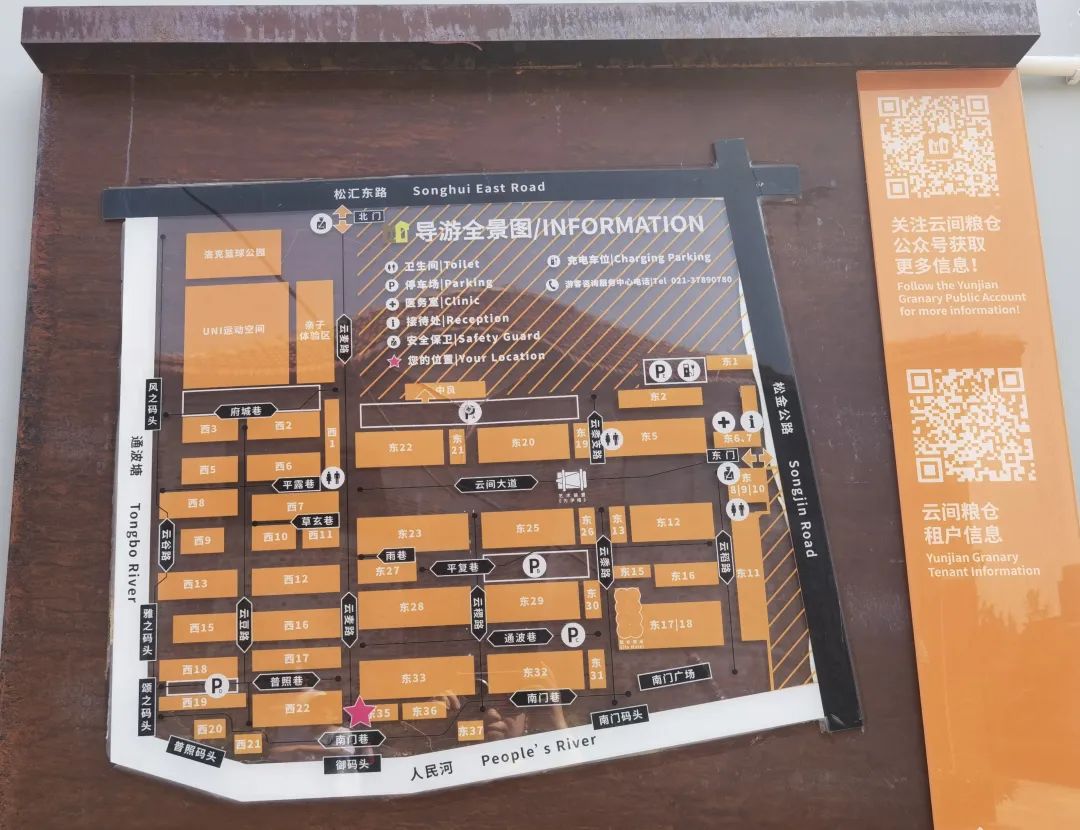
After going to Yunjian Granary, I realized that Songjiang has such a beautiful nickname - Yunjian.
In the 1950s, the Nanmen Grain Depot was completed in the former Songjiang County in the outer suburbs. Subsequently, a number of grain warehouses and factories such as rice mills, flour mills, and feed mills were born, witnessing the development of the grain industry since the founding of New China. development and evolution.
As time goes by, the facilities of the granary have become obsolete, and the warehouse is simple and aging, and is no longer suitable for use as a granary. The old granary that had been abandoned for many years has now been renovated and renovated into a cultural and creative park . Because Songjiang (called Huating in ancient times) was also called Yunjian during the Western Jin Dynasty, the Yunjian Granary got its name.
During the National Day period, we wanted to go to some niche places with fewer people, so we came here.

In the park, more than 40 single-story sloping roof granaries were built successively from the 1950s to the 1990s. Today, the mark of time and the changes of the years can still be felt in these granaries with red bricks and blue tiles.



However, the paintings and graffiti on the walls have given these old granaries a new vitality, showing an atmosphere of advancing with the times.



From the navigation map, we saw that there was a royal pier in the area of the waterfront platform, so we went looking forward to it.
However, the Royal Pier that I saw after going there was a bit disappointing, with two red brick pillars. If it weren't for a sign hanging on one of the pillars that said "Yu Pier", the original place where Kangxi shot arrows, we wouldn't have known that this was the "Yu Pier".
Later, I checked the information and learned that in ancient times, Songjiang had always enjoyed the reputation of "half the world's taxes and taxes" and "the world's clothing and quilts". Since the Ming Dynasty, Songjiang has become the main source and storage place for grain. It is also one of the main distribution centers for grain in Jiangsu and Zhejiang, forming a unique grain culture. Yunjian Granary is located at the junction of Tongbo Pond and Renmin River, with Tongbo Pond to the west and Renmin River to the south. It is a geomantic treasure land that looks like two rivers holding each other in arms. Emperor Kangxi landed here twice during his two voyages to the south of the Yangtze River. So it’s not surprising that this was once the Royal Pier.
But now, when I see this very inconspicuous place, I feel that the prosperity has disappeared and the world has changed.



This eight-building silo with a height of 24 meters and a diameter of 5.5 meters should be regarded as the iconic landscape of Yunjian Granary. It feels very special when I see it from a distance.
It turned out to be a silo where raw materials were stored in Songjiang Flour Mill. Now it is painted with a huge painting - "Rice Field Watchers". Four astronauts are walking in the rice fields, holding rice in their hands and looking up at the stars. What they contain is the secret of Songjiang rice aerospace breeding. theme.


The former grain drying field now houses a unique sculpture that looks like a huge trumpet. This is the contemporary art installation "Sing for Yi" from the Shanghai Biennale. People vividly call it "more cute" .



We walked around and saw an art exhibition in a granary - Starry Travel in the Clouds. Governance Graffiti Art Exhibition. The theme of the art exhibition involves the vast universe and the vast starry sky. The content is unconstrained and full of imagination.









After coming out, the two little ones saw the vegetable market in another granary, and finally found something they liked to play with!
In fact, when they first arrived here, the two little ones felt that it was not fun and wanted to leave. At that time, I encouraged them that they would have to do some research before they could draw a conclusion.
Later, we walked around and found that not only were there few people here, many shops were closed, and there were few exhibitions and other activities. It seemed a bit deserted, and it was indeed not fun.
Fortunately, they came across the vegetable market and were so addicted to it that they had no intention of leaving~





After playing for a long time, they were still reluctant to leave. After getting in the car, I asked them, if they said they didn’t want to play and wanted to leave when they arrived, did it hurt to be slapped in the face now? They were indifferent.
So I said, let’s go to a new place and we’ll know whether it’s fun or not after exploring it. Maybe it’s not fun, maybe it’s fun like it is now, but if you don’t explore it, you’ll never know the result, right? They nodded in agreement, thoughtfully.
In fact, I am also sighing in my heart, no wonder the children are so happy and carefree, because they are so easily satisfied. With such a few small objects and a small venue, they can have so much fun!
Looking back on ourselves, in the early days of our lives, weren’t we happy for a lollipop, happy for a picture, and satisfied for a doll? The older I get, the more things I experience, the more joys and sorrows I can bear, and I gradually become numb, slowly forgetting the surprises brought by that flower and that grass when I was young. The emotion brought about.
When I spend time with them, I often have some insights. I realize that I am contented and always happy. I realize that there is love in my heart and light in my eyes. I realize that I can perceive the world purely!
